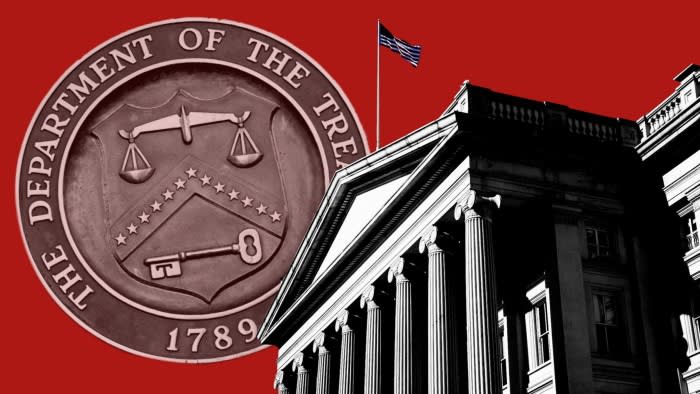A sell-off in US Treasuries has sent ripples through markets from gold to currencies, as investors warn that volatility is “locked in” ahead of next month’s presidential election.
US government bonds are on track for one of their worst months in recent years, with 10-year yields moving up almost 0.4 percentage points to 4.2 per cent after strong economic data and an emerging “Trump trade” sent traders scrambling to redraw their expectations of the path of interest rates.
The reversal has come just weeks after the US Federal Reserve signalled that an era of easing had begun with a half-percentage point cut, prompting investors to expect at least a further quarter-point cut at both remaining meetings this year.
Now, stronger economic data and bets on the rising chance of a Republication victory leading to reflationary policies have prompted investors to scale back those bets.
Mike Cudzil, a portfolio manager at Pimco, said investors were “walking back some of the overzealousness” after the Fed cut.
“It’s a pattern that’s taken hold in markets over the past 18 months,” he said. “Markets really grab a hold of a narrative and run out that narrative, and outrun the narrative, and take prices too far.”

Rob Burrows, a government bond fund manager at M&G Investments, said some of the dovish bets had been driven by a “fear of missing out on the rate-cutting cycles” for investors conditioned in the low-rate era that followed the global financial crisis.
Then with strong job numbers supporting the view that less drastic cuts would be needed, the “market took fright”, Burrows added. “Sometimes it’s a small door and we all try and run out that same door.”
The US shift has swept across global markets: the dollar is having its best month in two years against a basket of currencies, up more than 3 per cent over the past month.
This pushed the yen down below the ¥150 to the dollar level, prompting warnings from officials about the currency’s weakness, while the Mexican peso — which has been a victim of former president Donald Trump’s tariff threat on imported cars — has also suffered.
The recent economic data had “poured cold water” on the need for another half-point rate cut, said Mark Cabana, head of US rates strategy at Bank of America, and “forced” the market to pull back its expectation of a US recession.
Trading in swaps markets shows there is a significant possibility that the Fed will now hold rates at one of its two remaining meetings this year. Volatility in the Treasuries market, as measured by the Ice BofA Move index, this week reached its highest level since the end of last year as traders adjusted their positions.
“The uncertainty comes from multiple places — the economic fundamentals, the Fed’s reaction function and the political environment, which could drive changes in fiscal policy,” said Akshay Singal, global head of short-term interest rate trading at Citigroup.
The path of rate-cutting was “much wider than it has been in the past”, added Singal, saying there was a plausible scenario in which the Fed did not cut at all in 2025 and another where it cut by 1.25 percentage points or more.
Several investors said the greater volatility and uncertainty came from the market’s greater focus on jobs data after inflation started to fall.
An unexpectedly weak number in July, which laid the ground for the Fed’s decision for a half-point cut, was followed two months later by a payrolls report that smashed expectations.
William Vaughan, associate portfolio manager at Brandywine Global Investment Management, said for global bond markets “volatility is locked in for the short to medium term” as investors await the UK Budget, US election and key central bank decisions.
Added to this have been expectations that a shortening in the election odds for Trump has increased the likelihood of tariffs, tax cuts and other policies that will stoke domestic inflation, and put upward pressure on bond yields.
Strategists have pointed to the rise in the so-called term premium — the proportion of long-term bond yields that does not reflect near-term interest rate expectations — as a proxy for the concerns of investors about heavy borrowing by governments.
Fiscal and political uncertainties have lifted other haven assets such as precious metals, helping to propel gold to a record high.
Treasuries investors are now girding for a prolonged period of uncertainty through the election but also on the economy, with strikes and hurricanes in October expected to make that month’s US job data hard to read.
“It’s going to be difficult to decipher where we are in the US [economic cycle] because that data is going to be quite noisy,” said Laura Cooper, head of macro credit at asset manager Nuveen.
Still, some investors now warn that yields might have risen too high, in what is still expected to be an easing cycle for the US and most other major central banks.
Jim Caron, chief investment officer of the portfolio solutions group at Morgan Stanley Investment Management, highlighted that inflation had been trending lower and the Fed was still expected to cut.
“In the end, bond yields may remain contained and this is not likely [to be] the start of a new trend to higher yields [but] just an adjustment.”
The “pendulum has swung the other way” from investors overestimating how much the Fed would cut to understating it, argued Ed Al-Hussainy, senior global rates strategist at Columbia Threadneedle Investments.
“My sense is markets at the moment, because they’re so euphoric about growth, so hypersensitive about fiscal deficits increasing . . . [they] are underpricing how much the Fed will have to do. This is a bet I’m placing.”
https://www.ft.com/content/d1452378-2980-42a4-877c-6a84b7ed6fcd


